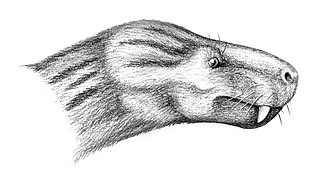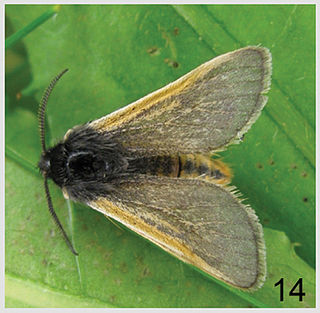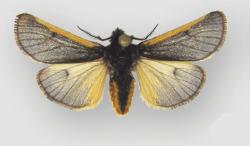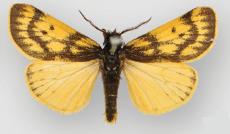Branisella is an extinct genus of New World monkey from the Salla Formation of what is now Bolivia during the Late Oligocene, approximately 26 million years ago (Deseadan), comprising only the species Branisella boliviana. Together with the Peruvian genus Canaanimico, it is the oldest fossil New World monkey discovered.

Hamptophryne boliviana, also known as the Bolivian bleating frog or Amazon sheep frog, is a species of frogs in the family Microhylidae. It is found in the northern and western sides of the Amazon basin in Bolivia, Brazil, Colombia, Ecuador, French Guiana, Guyana, Peru, Suriname, and Venezuela. Genetic analysis suggests hidden diversity within the nominal species.

The Yungas manakin is a species of bird in the family Pipridae. It closely resembles the blue-backed manakin, but unlike that species it has dull dark red legs and is found in humid highland forests in the Yungas of southeastern Peru and Bolivia.

Brunellia is a genus of trees. They are distributed in the mountainous regions of southern Mexico, Central America, West Indies, and South America. Brunellia is the only genus in the family Brunelliaceae. As of 2001 there were about 54 species.

Correbia is a genus of moths in the subfamily Arctiinae. The genus was erected by Gottlieb August Wilhelm Herrich-Schäffer in 1855.
Grand Marshal of Peru, commonly referred as Marshal of Peru, is the highest rank in the Peruvian Army. Unlike the other ranks, it is conferred only to an officer who has been victorious at war.
Vasqueziella is a genus of orchids. Only one species is known, Vasqueziella boliviana, native to Peru and Bolivia.

Charassognathus is an extinct genus of Late Permian cynodonts. Described in 2007 from a locality near Fraserburg, South Africa, Charassognathus is one of the earliest and most basal cynodonts. It is known only from the holotype, which dates from the Late Permian Period. The type and only species is C. gracilis. The holotype, found in the Tropidostoma Assemblage Zone of the Teekloof Formation, is made up of a crushed skull, partial lower jaw and one leg.

Minthostachys is a genus of the mint family Lamiaceae, comprising aromatic scandent shrubs. It occurs along the Andes from Northern Venezuela through Colombia, Ecuador, Peru and Bolivia to Central Argentina.

Phragmatobia is a genus of moths in the subfamily Arctiinae described by James Francis Stephens in 1828. Many tiger-moth species of small and medium size were described within this genus. However, only a few are related to the type species.
Apurimacia is a genus of flowering plants in the family Fabaceae. It belongs to the subfamily Faboideae. It includes two species native to South America. The species Apurimacia dolichocarpa is a shrub endemic to the Sierras de Córdoba in Argentina. The species Apurimacia boliviana is a tree native to Peru and Bolivia. It is used as an insecticide in Peru.
Mionothropus is an extinct genus of nothrotheriine nothrotheriid sloth which existed in Peru in the western Amazon Basin, during the late Miocene. It is known from the holotype LACM 4609/117533, which includes cranial remains, recovered from the riverbank deposits of the Iñapari Formation in the Río Acre region, were originally assigned to Nothropus priscus. It was first named by Gerardo De Iuliis, Timothy J. Gaudin and Matthew J. Vicars in 2011 and the type species is Mionothropus cartellei. The generic name is derived from "Mio", is a reference to the Miocene provenance of the holotype, and "nothropus" refers to the initial allocation of the holotype to this genus from the South American Pleistocene. The specific name honours Dr. Castor Cartelle.

Andesobia is a genus of moths in the subfamily Arctiinae.

Andesobia jelskii is a species of moth of the subfamily Arctiinae first described by Charles Oberthür in 1881. It is found in the Department of Junín in Peru.

Andesobia boliviana is a species of moth of the subfamily Arctiinae first described by Max Gaede in 1923. It is found in Peru and Bolivia.

Andesobia sanguinea is a species of moth of the subfamily Arctiinae first described by George Hampson in 1907. It is found in the Lake Titicaca region of Peru and Bolivia.
Juglans boliviana, also known as Bolivian walnut, is a tree in the family Juglandaceae. According to a paper in 1960 entitled The Genus Juglans in South America and the West Indies by American horticulturist and botanist Wayne Eyer Manning, it occurs in the Andes of northern Bolivia.
Robinsonia boliviana is a moth in the family Erebidae. It was described by Adalbert Seitz in 1921. It is found in French Guiana, Peru and Bolivia.

The Matapalo broad-nosed bat is a species of leaf-nosed bat described in 2005. It is found in South America.
Rhogeessa velilla, also called the Ecuadorian little yellow bat, is a species of vesper bat in the genus Rhogeessa. It is found in Northwestern Peru and parts of Ecuador. The species was previously included in R. io, but is now recognized as a separate species. Very little is known about this species, though it is generally considered to be insectivorous.








